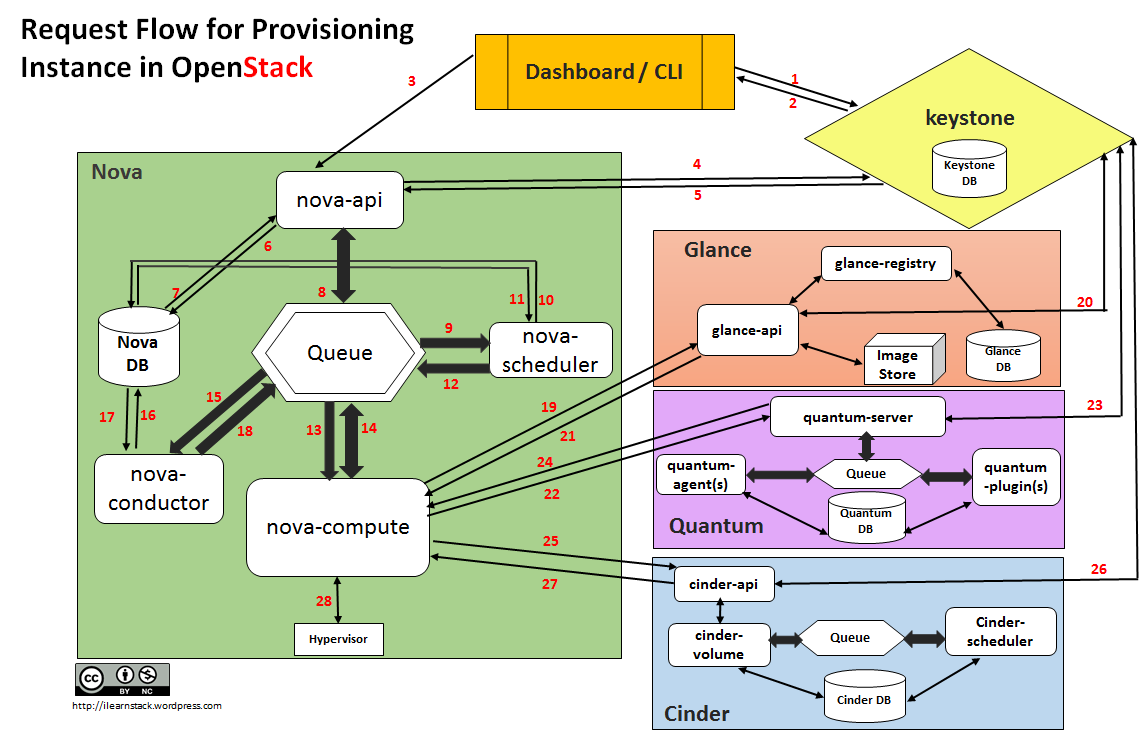[转]Request Flow for Provisioning Instance in Openstack
One of the most important use-case in any cloud is provisioning a VM . In this article we shall do a walk through about an instance(VM) being provisioned in a Openstack based cloud. This article deals with the request flow and the component interaction of various projects under Openstack. The end result will be booting up a VM.
Provisioning a new instance involves the interaction between multiple components inside OpenStack :
- CLI Command Line Interpreter for submitting commands to OpenStack Compute.
- Dashboard (“Horizon”) provides the interface for all the OpenStack services.
- Compute (“Nova”) retrieves virtual disks images(“Glance”) , attach flavor and associated metadata and transforms end user API requests into running instances.
- Network (“Quantum”) provides virtual networking for Compute which allows users to create their own networks and then link them to the instances.
- Block Storage (“Cinder”) provides persistent storage volumes for Compute instances.
- Image (“Glance”) can store the actual virtual disk files in the Image Store.
- Identity (“Keystone”) provides authentication and authorization for all OpenStack services.
- Message Queue(“RabbitMQ”) handles the internal communication within Openstack components such as Nova , Quantum and Cinder.
The request flow for provisioning an Instance goes like this:
- Dashboard or CLI gets the user credential and does the REST call to Keystone for authentication.
- Keystone authenticate the credentials and generate & send back auth-token which will be used for sending request to other Components through REST-call.
- Dashboard or CLI convert the new instance request specified in ‘launch instance’ or ‘nova-boot’ form to REST API request and send it to nova-api.
- nova-api receive the request and sends the request for validation auth-token and access permission to keystone.
- Keystone validates the token and sends updated auth headers with roles and permissions.
- nova-api interacts with nova-database.
- Creates initial db entry for new instance.
- nova-api sends the rpc.call request to nova-scheduler excepting to get updated instance entry with host ID specified.
- nova-scheduler picks the request from the queue.
- nova-scheduler interacts with nova-database to find an appropriate host via filtering and weighing.
- Returns the updated instance entry with appropriate host ID after filtering and weighing.
- nova-scheduler sends the rpc.cast request to nova-compute for ‘launching instance’ on appropriate host .
- nova-compute picks the request from the queue.
- nova-compute send the rpc.call request to nova-conductor to fetch the instance information such as host ID and flavor( Ram , CPU ,Disk).
- nova-conductor picks the request from the queue.
- nova-conductor interacts with nova-database.
- Return the instance information.
- nova-compute picks the instance information from the queue.
- nova-compute does the REST call by passing auth-token to glance-api to get the Image URI by Image ID from glance and upload image from image storage.
- glance-api validates the auth-token with keystone.
- nova-compute get the image metadata.
- nova-compute does the REST-call by passing auth-token to Network API to allocate and configure the network such that instance gets the IP address.
- quantum-server validates the auth-token with keystone.
- nova-compute get the network info.
- nova-compute does the REST call by passing auth-token to Volume API to attach volumes to instance.
- cinder-api validates the auth-token with keystone.
- nova-compute gets the block storage info.
- nova-compute generates data for hypervisor driver and executes request on Hypervisor( via libvirt or api).
The table represents the Instance state at various steps during the provisioning :






【推荐】国内首个AI IDE,深度理解中文开发场景,立即下载体验Trae
【推荐】编程新体验,更懂你的AI,立即体验豆包MarsCode编程助手
【推荐】抖音旗下AI助手豆包,你的智能百科全书,全免费不限次数
【推荐】轻量又高性能的 SSH 工具 IShell:AI 加持,快人一步
· AI与.NET技术实操系列:向量存储与相似性搜索在 .NET 中的实现
· 基于Microsoft.Extensions.AI核心库实现RAG应用
· Linux系列:如何用heaptrack跟踪.NET程序的非托管内存泄露
· 开发者必知的日志记录最佳实践
· SQL Server 2025 AI相关能力初探
· winform 绘制太阳,地球,月球 运作规律
· 震惊!C++程序真的从main开始吗?99%的程序员都答错了
· 【硬核科普】Trae如何「偷看」你的代码?零基础破解AI编程运行原理
· 超详细:普通电脑也行Windows部署deepseek R1训练数据并当服务器共享给他人
· AI与.NET技术实操系列(五):向量存储与相似性搜索在 .NET 中的实现